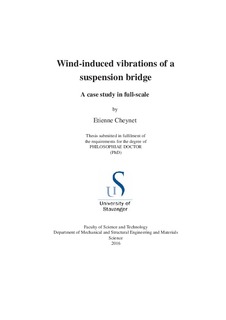| dc.contributor.advisor | Jakobsen, Jasna Bounovic | |
| dc.contributor.author | Cheynet, Etienne | |
| dc.date.accessioned | 2016-12-19T13:33:26Z | |
| dc.date.available | 2016-12-19T13:33:26Z | |
| dc.date.issued | 2016-12-16 | |
| dc.identifier.citation | Wind-induced vibrations of a suspension bridge: A case study in full-scale by Etienne Cheynet, Stavanger : University of Stavanger, 2016 (PhD thesis UiS, no. 326) | nb_NO |
| dc.identifier.isbn | 978-82-7644-691-3 | |
| dc.identifier.issn | 1890-1387 | |
| dc.identifier.uri | http://hdl.handle.net/11250/2425472 | |
| dc.description | PhD thesis in Konstuksjonsteknikk og materialteknologi | nb_NO |
| dc.description.abstract | In 2013, the Norwegian government adopted an ambitious plan to cross the wide and deep-fjords of Western Norway and create a ferry-free coastal high- way route. This implies the construction of multiple long-span bridges (even up to 5 km long) and in particular long-span suspension bridges. Because of their size and lightness, such structures will be particularly sensitive to environmental effects including wind turbulence. Yet, there are only relatively few studies available on wind effects on long-span bridges in full-scale and in complex terrains. Sonic anemometers fixed to a measurement mast on land are traditionally utilized to monitor wind turbulence. Recent development of remote wind sensing technologies can introduce a complementary tool for mapping the flow over several kilometres wide fjords, more representative of the future bridge exposure.
These challenges are addressed in the present thesis by studying the wind- induced vibrations of an existing suspension bridge, in full-scale. The Lyse- fjord Bridge, located in South-Western Norway is used as a case study. Since November 2013, it has been instrumented with multiple sonic anemometers and accelerometers. During spring 2014, two short measurement campaigns were conducted with single and dual Doppler wind lidar systems to assess their capabilities in capturing the turbulence characteristics relevant to bridge design. This thesis is structured around three main axes that are central for a systematic validation of the buffeting theory in full-scale. Firstly, a detailed investigation of the flow conditions at the bridge site is performed, by utilizing both the data from the anemometers and the Doppler Wind lidars. Secondly, the modal parameters of the Lysefjord Bridge are identified by using an operational modal analysis. Thirdly, the buffeting response of the Lysefjord Bridge is evaluated.
Discussion focuses on the sources of the discrepancies between the measured and the computed responses, selected for a detailed comparison. Sonic anemometer records document two main wind directions (N-NE and S-SW) on the bridge site. The turbulence properties of the flow are characteristically different for these two main wind directions, so that a case-by-case approach is necessary to study the statistics of wind turbulence. The application of a single long-range pulsed wind lidar 1.75 km west of the bridge illustrated the potential of a wind lidar to capture single-point statistics of wind turbulence at distances larger than 1 km. However, a multi-lidar configuration is needed for a more complete survey of turbulence. In particular, the deployment of the short-range WindScanner system on the bridge deck demonstrated the potential of dual-wind lidar systems to measure the coherence of wind.When it comes to structural health monitoring of the Lysefjord Bridge, a time-efficient automated covariance-driven stochastic subspace identification method was applied on six months of continuous bridge acceleration records. Results from this modal identification procedure have highlighted the dependency of the eigen-frequencies and modal damping ratios of the bridge deck on the wind velocity and temperature fluctuations. The good agreement between the measured and computed modal parameters has been identified, which allowed a detailed comparison of the measured response with the computed one in the frequency domain. Discrepancies larger than expected were observed for the standard deviation of the lateral and the vertical bridge displacement response for the N-NE exposure. The differences may be attributed to various factors, including the influence of the topography on the flow properties and the possible disturbance of the observed flow field by the bridge deck. | nb_NO |
| dc.language.iso | eng | nb_NO |
| dc.publisher | University of Stavanger, Norway | nb_NO |
| dc.relation.ispartofseries | PhD thesis UiS;326 | |
| dc.rights | Copyright the author, all right reserved | |
| dc.rights | Navngivelse 4.0 Internasjonal | * |
| dc.rights.uri | http://creativecommons.org/licenses/by/4.0/deed.no | * |
| dc.subject | broer | nb_NO |
| dc.subject | brokonstruksjon | nb_NO |
| dc.title | Wind-induced vibrations of a suspension bridge: A case study in full-scale | nb_NO |
| dc.type | Doctoral thesis | nb_NO |
| dc.rights.holder | Forfatteren | nb_NO |
| dc.subject.nsi | VDP::Teknologi: 500::Bygningsfag: 530::Konstruksjonsteknologi: 533 | nb_NO |

